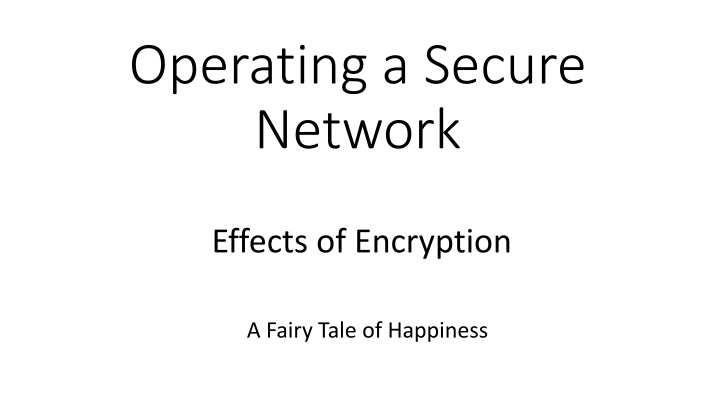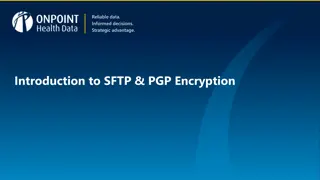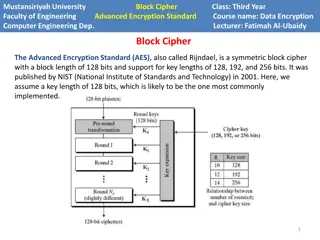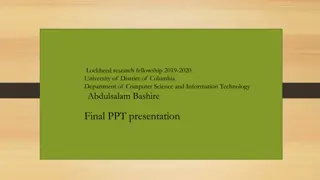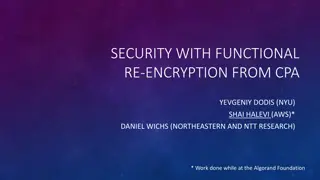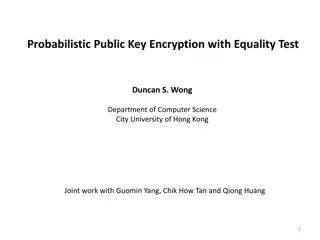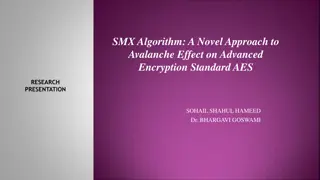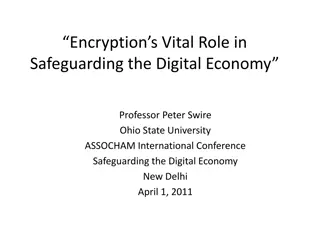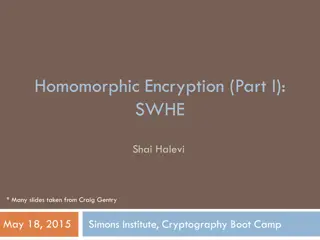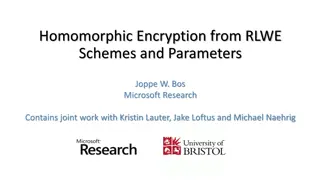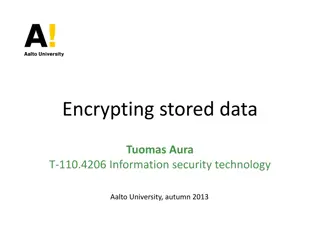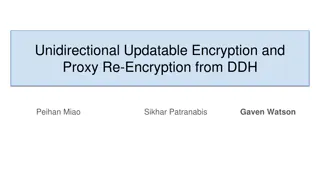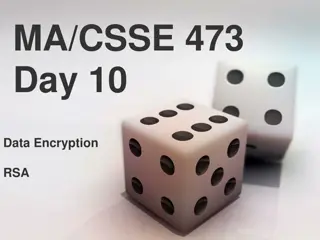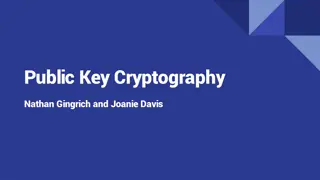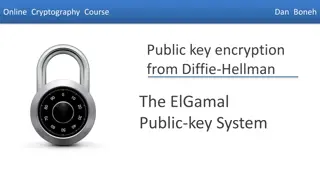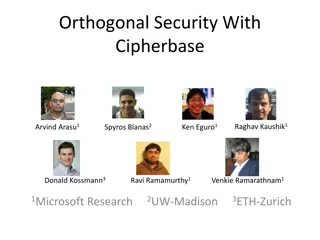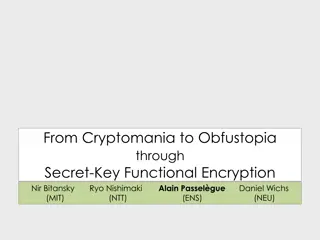Operating a Secure Network: Effects of Encryption
A fairy tale of happiness intertwined with a grain of reality in the world of network security. Explore the importance, challenges, and evolution of encryption in securing networks against pervasive monitoring and privacy concerns, while adapting to changing trends and threats.
Download Presentation

Please find below an Image/Link to download the presentation.
The content on the website is provided AS IS for your information and personal use only. It may not be sold, licensed, or shared on other websites without obtaining consent from the author.If you encounter any issues during the download, it is possible that the publisher has removed the file from their server.
You are allowed to download the files provided on this website for personal or commercial use, subject to the condition that they are used lawfully. All files are the property of their respective owners.
The content on the website is provided AS IS for your information and personal use only. It may not be sold, licensed, or shared on other websites without obtaining consent from the author.
E N D
Presentation Transcript
Operating a Secure Network Effects of Encryption A Fairy Tale of Happiness
A Fairy Tale With a grain of reality though.
A Feeling of Security Pervasive Monitoring is a problem. Let s Address Pervasive Monitoring with Pervasive Encryption. Problem solved. Just at what cost?
Encryption in the network Has been around for long. At different layers. Done in different ways. Authentication and encryption. Opportunistic encryption, strong end to end encryption. Accessibility of encryption.
Relativity of Importance Privacy concerns should not make the network to become unmanageable. The network has to work. No service vs degraded service vs full service. No privacy vs compromised privacy vs full privacy.
Is Everything Broken? Access to cleartext traffic and user identities certainly helps. It is not mandatory though. The times of running debug all on a production node have mostly passed. Lack of access to cleartext payload and signalling may result in development of inherently flawed/insecure/damaging operational practices and protocol extensions.
General Trends Attacks will not get worse. Attacks will only get better. Application to network interface. Traffic type distribution is narrowing. HTTP over TLS as the universal transport protocol. The level of encryption in use is not going to decrease.
The Context The scope of monitoring from a sniffer on a home wireless link to monitoring country egress links. Use to user (application to application) vs session level encryption vs transport level encryption. Transit providers, application providers, hosting providers. Eyeballs vs service/content generation Datacenter as the new core of the network. Decryption/termination of ingress sessions and keeping intra- DC traffic clear. Scale of decryption.
Transport interaction Encryption itself does not change the bit rate much. Special concealment measures as padding and size adjustment may do. Multiplexing (HTTP2, QUIC) may change bit rate a lot. Overlays and insecure underlay. Bandwidth requirements 100G is certainly there, but mobile links are also present. Encryption of lower transport layers optical.
Security Policy Unauthorized traffic tunnelling over specific application ports HTTP as the universal tunnelling protocol. Security policy compliance due to lack of visibility. Data Loss Prevention mechanisms work on unencrypted streams. Object hashing is not reliable enough. Enterprise policy enforcement viruses, worms, tojans, data leaks, malware protection. Central control vs control at the end points.
Cat Videos My video is broken. Your encryption broke it. DPI visibility. CDN optimization. HTTP redirect for usage based billing. Content size and partial transfers. Zero rating content reachability. Real-time media signalling needs to be visible to intermediate network elements.
Key Management Key management at scale. The location of the problem transport, application, or key management? Attacks on key management tend to be more productive.
DoS Presence of DoS attack traffic not related to the application use. Fingerprinting, DoS protection, visibility into attack traffic. Intelligent DoS attacks/information theft vs brute force traffic based DoS.
Load Balancers and Optimizers Integrated and standalone load balancers. Anycasting on custom header fields. Visibility into headers. TLS interception on load balancing environments. Performance enhancing proxies, long distance transport optimizations. Content, advertisement injection need a better dedicated mechanism for that. ALGs and middleboxes are here to stay.
Lawful Intercept Lawful Intercept has to work. This is not a topic for joking. A thin line between lawful and unlawful intercept.
OAM Packet marking for OAM purposes. Passive monitoring, service level OAM, SLA validation. Synthetic service probes.
Caching and Storage Data at rest encryption. Deduplication. Blind caching. Content compression. Content blocking. Encryption decreases effectiveness of caching.
Network Management and Operations Decryption for troubleshooting purposes is done by offline encryption by using private keys available out of band. This is a common practice. Tooling is important.
Network Infrastructure Evolution of RPF and control plane snooping. Application performance and monitoring, network diagnostics and troubleshooting. 2-tuple, 5-tuple analysis for various places in network and encryption technologies. Filtering based on URL lookup and DNS resolution Encrypted DNS.
QoS Traffic conditioning and marking on encrypted payload. Everything is HTTP over TLS, web page and websocket based realtime communication is just HTTP over TLS. Congestion management according to application traffic.
Do we need to encrypt less? No. We need to find better ways to operate in encrypted environment instead. And we need to realize that there will be attempts to block encryption. We should do no evil on the network too. This one seems a bit harder to achieve though.
Way Forward IETF is working on a set of recommendations for widespread encryption deployment. Please provide feedback on your experiences with encryption. There may be broken/suboptimal things and incorrect assumptions. That needs to be addressed and fixed.
Discussion All fairy tales eventually come to an end.
